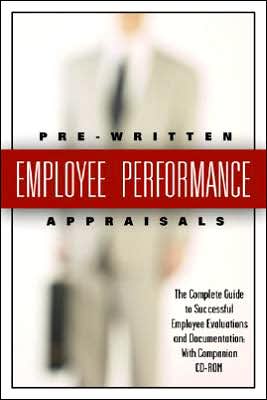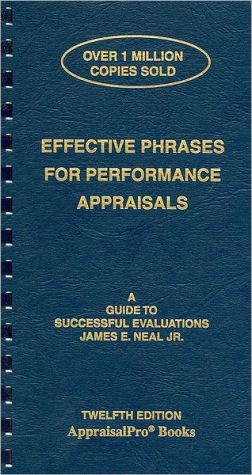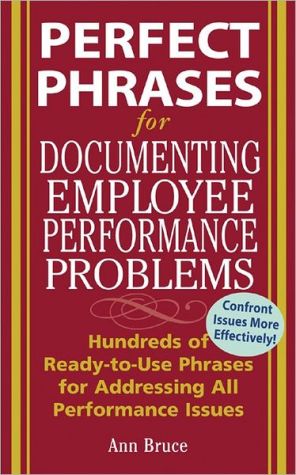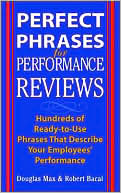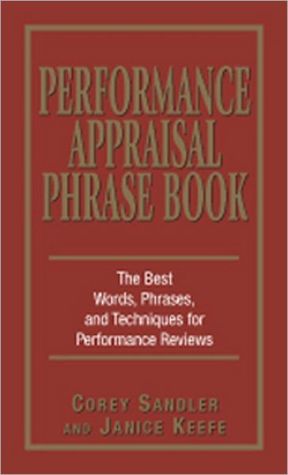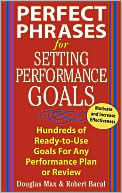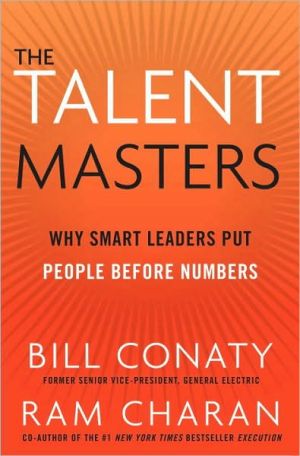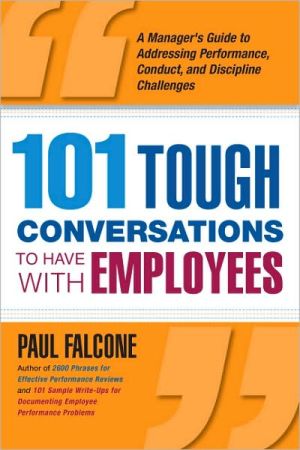199 Pre-Written Employee Performance Appraisals: The Complete Guide to Successful Employee Evaluations and Documentation
No matter what type of business or even nonprofit organization you are managing, a written performance appraisal is good management. Employee reviews can serve as a platform for employees to bring forth questions and concerns. This can help increase employee dedication, creativity, and job satisfaction. Reviews allow you to evaluate employees for increased responsibilities and future promotions. You will have written records of your employees performance, get more productivity, and clearly...
Search in google:
No matter what type of business or even nonprofit organization you are managing, a written performance appraisal is good management. Employee reviews can serve as a platform for employees to bring forth questions and concerns. This can help increase employee dedication, creativity, and job satisfaction. Reviews allow you to evaluate employees for increased responsibilities and future promotions. You will have written records of your employees performance, get more productivity, and clearly set compensation. Employee appraisals are critical to your organization, but are time-consuming to write. This new book and companion CD-ROM is your solution. You will produce professional-quality performance reviews in minutes. The book provides over 199 pre-written employee phrases you can insert into a blank employee appraisal form. The evaluations are professional, constructive, and direct. See the accompanying CD-ROM for 25 different categories to evaluate your employee in. Each category includes at least 8 different phrases you can choose from to describe your employees performance in that category. Pick and choose which categories you would like to include in your employees performance appraisal and how you want to describe your employees performance in that category and then just insert them all into the prepared appraisal form.
199 PRE-WRITTEN EMPLOYEE PERFORMANCE APPRAISALS\ The Complete Guide to Successful Employee Evaluations and Documentation \ \ By Stephanie Lyster Anne Arthur \ Atlantic Publishing Group, Inc.\ Copyright © 2007 Atlantic Publishing Group, Inc.\ All right reserved.\ ISBN: 0-910627-76-2 \ \ \ Chapter One\ INTRODUCTION\ WHY THIS GUIDE?\ Welcome to 199 Pre-Written Employee Performance Appraisals: The Complete Guide to Successful Employee Evaluations and Documentation. There are dozens of employee evaluation guides on the market today. So why select this one, right?\ We created 199 Pre-Written Employee Performance Appraisals for novices and experienced managers alike. Whether you're preparing to conduct your first performance review or you're an experienced manager looking to redesign your organization's performance evaluation process, you'll find the tips and information here to satisfy your every need.\ The information contained in this guide comes from experienced human resources professionals with significant experience in the public and private sectors. It is applicable to your organization, small or large, regardless of your industry or organizational focus.\ Deciding on a performance review system is challenging at best. It is important that you begin fully armed with factual and up-to-date information about the performance review process. Fortunately, you'll find just the information you need in this book. It's simple and direct, and you won't have to wade through complex explanationsto understand the ins and outs of performance reviews.\ This book is designed with managers in mind, but it also provides valuable information for employees and organizational executives.\ GOALS AND OBJECTIVES\ The primary goals and objectives of this book include providing managers with up-to-date, direct information about the performance evaluation process. Inside, you'll learn how to design an effective performance evaluation, what the most common types of evaluations are, and how to implement, oversee, and maintain a performance review system.\ In Chapter Two, you'll discover exactly what performance appraisals are and how to define an efficient performance appraisal process. Next, you'll learn about the types of performance appraisals available for large and small organizations. Chapters Four and Five provide valuable tools for conducting performance reviews legally and effectively. You'll learn everything there is to know about the performance review process from the planning stages through the employee interview.\ Later in this guide, we'll take you step-by-step through the performance interview process. You'll learn what qualities and skills to look for when evaluating employee performance and why those skills are important to the performance review system. You'll also learn what to avoid when conducting performance reviews, including the most common mistakes managers make when conducting performance reviews. Armed with this information, your reviews are bound to succeed every time!\ In Chapter Seven, we'll discuss trends in performance appraisals and in the human resources industry so your organization can stay competitive in the increasingly aggressive global marketplace. We'll close by providing you with tips for coaching employees through the performance review process and discussing special circumstance performance evaluations.\ See the accompanying CD-ROM for a performance appraisal with 25 different categories to evaluate your employee with. Each category includes about 8 different phrases you can choose from to describe your employee's performance in that category. Pick and choose which categories you would like to include in your employee's performance appraisal and how you want to describe your employee's performance in that category.\ PURPOSE\ The purpose of this book is to help you become a performance appraisal expert. You should use it as your guide to performance appraisal success. After reading this book, you will have the tools and skills necessary to coach others in the performance evaluation process. You'll also be able to design a performance appraisal system unique to your organization or recommend changes to your organization's current performance review system.\ WHY PAY FOR PERFORMANCE?\ Today's business marketplace has become extremely competitive. As technological innovations promote more communications, the global business environment is increasingly fraught with chaos. It is important in this chaotic environment that organizations find ways to stay competitive.\ One of the best ways you can stay competitive in the global marketplace is by rewarding your employees for exceptional performance. While your performance appraisal process does not need to be salary-driven, it does need to recognize employees for outstanding achievement. A performance review process should incorporate the organization's goals, beliefs, values, and mission. Then, the review process becomes an integral part of the organizational culture.\ Employees who are routinely recognized and rewarded for their contributions are much more likely to remain motivated and loyal to the company they work for. They are also more likely to promote collaborative efforts and communication throughout the organization. Performance reviews are among the best tools available for promoting organizational excellence and communication among employees.\ By now you've probably heard of the term knowledge-sharing, which, while only vaguely defined by some organizations, is the key to staying competitive in the global marketplace.\ Knowledge-sharing: The transferring of knowledge from one person to another or a group of people.\ How is knowledge-sharing related to performance? An organization that promotes exceptional performance is much more likely to engage in knowledge-sharing. Knowledge-sharing in the organization occurs through multiple channels, including the performance evaluation process. By rewarding employees for their performance, organizations open the doors to communication and encourage greater knowledge-sharing at all levels. You can't afford not to reward your employees for their performance in today's business environment.\ INTRODUCTION TO THE PERFORMANCE APPRAISAL PROCESS\ The performance appraisal process is a step-by-step system that an organization can adopt to foster exceptional performance.\ It provides organizations with a tool to evaluate an employee's strengths and weaknesses easily. Performance appraisals also provide managers and employees the opportunity for one-on-one communication and a method for sharing the organization's values, missions, goals, and objectives with all its members.\ There are many steps or stages in the performance evaluation process. Later in this book, we'll discuss each of these phases and their effects on the organization. What you need to know now is that the performance appraisal process is vital to the livelihood of your organization. A good system promotes communication, knowledge-sharing, and excellence within the organization. Our goal throughout this guide is to help you develop the best system for your organization so you too can achieve excellence.\ Chapter Two\ PERFORMANCE APPRAISALS DEFINED\ WHAT A PERFORMANCE APPRAISAL IS\ Managers and employees have defined performance appraisals in various ways throughout history. For you to understand exactly what a performance appraisal is and what purpose it serves, however, it is important to come up with a standard definition.\ A performance appraisal may go by many different names, including:\ Job performance review.\ Performance evaluation.\ Employee review.\ Employee performance evaluation.\ Employee feedback review.\ 360-degree evaluation.\ All these terms are valid; therefore, we will use them interchangeably throughout this book, while you learn more about the performance evaluation process. It is important that you differentiate between the performance review system and the performance appraisal itself. A performance review system or program is the process of reviewing employee performance. The performance appraisal or interview involves the actual forms and meetings used to carry out the process.\ In simple terms, an employee evaluation is a routine review that documents and analyzes employee performance. Typically, managers conduct performance reviews in person on an annual or semiannual basis.\ A performance review is an important tool that management can use to appraise the quality of any one individual's performance in the organization. It can also be used to help identify opportunities for growth and areas where extra training or additional guidance and support may be necessary.\ Managers can also use the performance appraisal to identify problems or performance shortfalls for disciplinary purposes or to document important events in the employee's career or tenure with an organization. Typically, the employee's direct supervisor takes charge of the review process.\ One way to understand the performance review is to understand what a performance review is not.\ A performance review is not an opportunity for blatant criticism of an employee without just cause.\ A performance review is not the primary means for firing or terminating employees, though a manager may use it to provide employees with feedback pending a termination.\ A performance evaluation is not a tool that supervisors should use to rate an employee's personality or personal traits.\ A performance assessment is not a negative process.\ Performance reviews are practical methods for providing factual and objective feedback about an employee's work performance. Examples of performance elements typically rated may include an employee's skills, work roles, goals, and objectives. Performance reviews provide a unique opportunity for employees and supervisors to connect and define important elements that eventually may help employees succeed. Performance reviews can also be an opportunity to strengthen the bond between the employee and supervisor.\ HISTORY OF PERFORMANCE REVIEWS\ The performance appraisal has a brief but important history. The first reviews were developed as part of formal management procedures shortly after World War II, when managers working in corporate enterprises decided that formal systems for evaluating performance would promote improved organizational profitability.\ The concept of performance reviews dates back many centuries. Human beings have for long periods of time appraised the work of one another to provide motivational support and guidance. Looking back in history, any form of coaching or mentoring might be considered the foundation of the modern performance review process.\ By nature, human beings want motivation in the workplace. A motivated employee is an employee who is more likely to encourage others and to collaborate to achieve organizational goals. In the last 60 years, organizations have begun to realize the significance of the performance review process, which systematically reminds employees of their goals and objectives and serves as an inspirational tool for development.\ The first appraisal systems probably consisted of nothing more than verbal feedback which has become the core of the performance review process. Today, meaningful feedback forms the foundation for an effective performance evaluation system. The goal of managers is to define a performance review system that will provide employees with the most meaningful feedback, applied in a productive and motivational manner.\ PURPOSE OF PERFORMANCE REVIEWS\ Performance reviews serve many purposes. The primary purpose of the employee review is to provide managers and employees the opportunity to meet face-to-face and identify how well an employee is meeting personal and organizational goals and objectives. The performance review serves many other useful functions, however, including:\ Providing feedback on performance.\ Justifying salary changes.\ Providing helpful criticism for employees.\ Providing goal- and objective-setting sessions.\ Allowing employees and employers time to connect.\ Encouraging employee achievement.\ Helping managers decide how to downsize.\ Improving employee performance.\ Providing feedback or justification for personnel decisions such as firing or promotion.\ Thus, the purpose of a performance evaluation is to help the employee set goals and to measure how well the employee achieves those goals. The purpose is not to use the review as a subjective instrument for evaluating an employee's personality or personal habits. Managers must always base performance evaluations on objective, well-defined criteria for validity. Therefore, performance appraisals rely on objective, factual data about an employee's performance.\ Performance appraisals also provide managers and employees a valuable opportunity to meet and discuss performance goals and decide on areas for improvement. Managers and employees alike can use performance evaluations to decide what steps an individual employee can take to help improve the organization's overall performance.\ Many assume that performance appraisals serve only as a management tool. They can, however, also be a tool for employees to communicate more effectively with their supervisors to establish a more meaningful and productive work relationship.\ At no other point during the year might an employee have as much time to consult with his or her supervisor about strategic objectives and pursuits of the organization. The employee can also use this time to learn more about his or her supervisor and the supervisor's goals or ambitions for the future.\ Meaningful, relevant feedback is the backbone of effective performance management systems. Human resources managers have long recognized that feedback is a motivational tool. Positive feedback serves to reinforce more desirable behaviors and extinguish less desirable ones. Interestingly, for many managers, providing feedback seems to be an abstraction. Some have a difficult time wrapping their heads around the feedback process. It is important, therefore, that organizations take the necessary time to train managers in providing constructive feedback.\ Feedback has to be valid, truthful, and relevant to be effective. Feedback that is used to manipulate employees is never effective; nor is feedback that lacks a factual foundation. Feedback must also be useful to be effective.\ In this guide, we'll discuss multiple methods for developing effective feedback. We'll also explore how to seek and use performance feedback to promote excellence within the organization.\ ESSENTIALS OF PERFORMANCE APPRAISALS\ Performance appraisals include several essential ingredients. For reviews to work effectively and correctly, managers must consider each of these ingredients or components. One is as important as the next. Here are the steps involved in the effective performance appraisal process:\ 1. Planning. For a performance appraisal to be effective, it must first be carefully planned. Typically, a manager is responsible for meeting with employees at least on an annual basis. During this meeting, the manager and employee should discuss the employee's goals and objectives for the coming year. These goals and objectives should be job-related, but should also incorporate the employee's personal career endeavors.\ During the planning phase, the manager decides how the employee's achievements or movement toward his or her goals should be evaluated.\ 2. Performance Evaluation. In the interim between performance reviews, the manager must evaluate whether the employee is achieving his or her goals. During the assessment phase of the review, the manager provides guidance and support to the employee and recommends areas for further improvement.\ (Continues...)\ \ \ \ \ Excerpted from 199 PRE-WRITTEN EMPLOYEE PERFORMANCE APPRAISALS by Stephanie Lyster Anne Arthur Copyright © 2007 by Atlantic Publishing Group, Inc.. Excerpted by permission.\ All rights reserved. No part of this excerpt may be reproduced or reprinted without permission in writing from the publisher.\ Excerpts are provided by Dial-A-Book Inc. solely for the personal use of visitors to this web site. \ \
